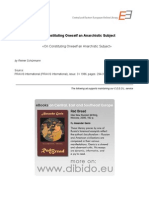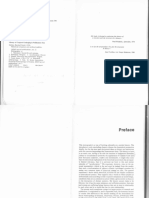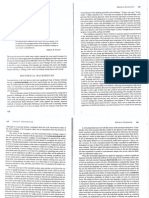0 ratings0% found this document useful (0 votes)
110 viewsArchive
Archive
Uploaded by
temi90This document discusses different perspectives on the concept of the archive from philosophers such as Foucault, Agamben, Ricoeur, and Sekula. Foucault viewed the archive as shaping our relation to the past and construction of history. Agamben argued the relation between sayable and unsayable becomes one between possibility and impossibility of speech for catastrophic events. Ricoeur saw the archive, document, and trace as measuring the relation between past and present. Sekula explored how the archive gains authority by establishing regulatory systems that codify and criminalize individuals.
Copyright:
Attribution Non-Commercial (BY-NC)
Available Formats
Download as DOCX, PDF, TXT or read online from Scribd
Archive
Archive
Uploaded by
temi900 ratings0% found this document useful (0 votes)
110 views2 pagesThis document discusses different perspectives on the concept of the archive from philosophers such as Foucault, Agamben, Ricoeur, and Sekula. Foucault viewed the archive as shaping our relation to the past and construction of history. Agamben argued the relation between sayable and unsayable becomes one between possibility and impossibility of speech for catastrophic events. Ricoeur saw the archive, document, and trace as measuring the relation between past and present. Sekula explored how the archive gains authority by establishing regulatory systems that codify and criminalize individuals.
Original Title
archive
Copyright
© Attribution Non-Commercial (BY-NC)
Available Formats
DOCX, PDF, TXT or read online from Scribd
Share this document
Did you find this document useful?
Is this content inappropriate?
This document discusses different perspectives on the concept of the archive from philosophers such as Foucault, Agamben, Ricoeur, and Sekula. Foucault viewed the archive as shaping our relation to the past and construction of history. Agamben argued the relation between sayable and unsayable becomes one between possibility and impossibility of speech for catastrophic events. Ricoeur saw the archive, document, and trace as measuring the relation between past and present. Sekula explored how the archive gains authority by establishing regulatory systems that codify and criminalize individuals.
Copyright:
Attribution Non-Commercial (BY-NC)
Available Formats
Download as DOCX, PDF, TXT or read online from Scribd
Download as docx, pdf, or txt
0 ratings0% found this document useful (0 votes)
110 views2 pagesArchive
Archive
Uploaded by
temi90This document discusses different perspectives on the concept of the archive from philosophers such as Foucault, Agamben, Ricoeur, and Sekula. Foucault viewed the archive as shaping our relation to the past and construction of history. Agamben argued the relation between sayable and unsayable becomes one between possibility and impossibility of speech for catastrophic events. Ricoeur saw the archive, document, and trace as measuring the relation between past and present. Sekula explored how the archive gains authority by establishing regulatory systems that codify and criminalize individuals.
Copyright:
Attribution Non-Commercial (BY-NC)
Available Formats
Download as DOCX, PDF, TXT or read online from Scribd
Download as docx, pdf, or txt
You are on page 1of 2
The Archive
1. In ‘The Archaeology of Knowledge’ (1969), the study of the archive was
compared by Michael Foucault to the practice of learning about the past
through its material remains. The ‘archaeologist of knowledge’ aims to
recover and reconstruct the archive, to reveal how it shapes or relation to
the past and the construction of historical meaning. For Foucault the
archive governs what is said or unsaid, recorded or unrecorded. His
analogy with archaeology is more expansive than Freud’s, discerning an
underlying structure governing the thought systems and values of any
given society and the conditions enable, a history to be written depend
upon the definition of the archive.
In response to Foucault, Giorgio Agamben argues that in light of the
phenomenon of the testimonial which has borne witness to catastrophic
events such as those of the Nazi era, there are conditions in which the
relation between the sayable and the unsayable becomes a relation
‘between a possibility and an impossibility of speech’ (Remnants of
Auschwitz: The Witness and the archive, 1989).
2. We may ask: What temporal zone does the document occupy, what if
its relation to the past, to the present and even to the future? Is what is
materially present, visible or legible adequate to an event that has passed
out of present time?
The second section, ‘Inscriptions’, examines ways in which the law of the
archive has been inscribed in definitions of the document and the body.
For Paul Ricoeur (‘Archives, Documents, Traces’, 1978), the concept of the
archive is synonymous with the trace and the document: in each we are
able to measure not only a relation between the past and present, but
between the event and evidence of its occurrence and between the fabric
of everyday life and its representation.
3. While Ricoeur focuses on the writing of history, Allan Sekula explores
how the archive gains its authority through establishing a science or
regulatory system that codifies the body in terms of equivalence. He
examines the tensions in nineteenth-century photography, in particular
photographic portraiture. This followed aesthetic conventions in presenting
the bourgeois self, yet also, drawing on the sciences of physiognomy and
phrenology, became an instrument for marking and criminalizing the
individual and social body. Photography became harnessed as an
apparatus of the state, facilitating the ‘arrest of the referent’. Sekula
draws on Water Benjamin’s observations on photography, especially his
remarks on photographers such as August Sander, whose protraits
σελ. 13: Ο Jacque Derrida επιστρέφει στο έργο του Freud «A note upon
the Mystic writing-pad», συνδέοντάς το με το πρόσφατο κείμενό του
«Beyond the pleasure Principle» (1920), προκειμένου να εξετάσει την
αρχειακή ώθηση, σε σχέση με αυτό που είδε ο Freud, την αδιαw
You might also like
- Proveedores ChinaDocument792 pagesProveedores ChinaDaniel Delafuente LópezNo ratings yet
- 7445-Theory As Practice FoucaultsDocument16 pages7445-Theory As Practice FoucaultsbeasseNo ratings yet
- 3.3 - Schürmann, Reiner - On Constituting Oneself An Anarchistic Subject (EN)Document18 pages3.3 - Schürmann, Reiner - On Constituting Oneself An Anarchistic Subject (EN)Johann Vessant RoigNo ratings yet
- Introduction To HistoryDocument9 pagesIntroduction To HistoryBea Kulin100% (1)
- The Big 6 SkillsDocument11 pagesThe Big 6 Skillswong sing lingNo ratings yet
- Tacita Dean - Contemporary Art, Archive Fever, and Alternative HistoryDocument23 pagesTacita Dean - Contemporary Art, Archive Fever, and Alternative History주인삑No ratings yet
- Truth Power and The SelfDocument48 pagesTruth Power and The SelfstigmaticoNo ratings yet
- Michel Foucault's Archeology of KnowledgeDocument10 pagesMichel Foucault's Archeology of KnowledgeAbuBakr Karolia100% (2)
- Key ConceptsDocument15 pagesKey Conceptsikonoclast13456100% (1)
- Symbolic and Structural Archaeology PDFDocument18 pagesSymbolic and Structural Archaeology PDFtwerkterNo ratings yet
- Rereading Michel Foucault and The Archaeology of Knowledge. - PrintableDocument2 pagesRereading Michel Foucault and The Archaeology of Knowledge. - Printablenoortjeschmit100% (1)
- The Archaeology of Photography Rereading Michel Foucault and The Archaeology of Knowledge David BateDocument5 pagesThe Archaeology of Photography Rereading Michel Foucault and The Archaeology of Knowledge David BateFelicia Brighidău100% (1)
- Michel Foucault - Ecole Normale Superieur Class NotesDocument18 pagesMichel Foucault - Ecole Normale Superieur Class NoteslzeynepsahinNo ratings yet
- Foucault 13032007Document23 pagesFoucault 13032007readeredaer100% (1)
- Foucault - Key ConceptsDocument12 pagesFoucault - Key ConceptsSara Hevia100% (2)
- This Content Downloaded From 177.76.21.107 On Sat, 26 Nov 2022 03:28:04 UTCDocument41 pagesThis Content Downloaded From 177.76.21.107 On Sat, 26 Nov 2022 03:28:04 UTCNati JaremkoNo ratings yet
- Materiality, Authenticity, and Skilled Engagement: A Commentary Julian ThomasDocument20 pagesMateriality, Authenticity, and Skilled Engagement: A Commentary Julian ThomasPatrycja FilipowiczNo ratings yet
- Numbered PagesDocument88 pagesNumbered PagesIAMAUGUSTINENo ratings yet
- Photography and The Material Turn in AnthropologyDocument6 pagesPhotography and The Material Turn in AnthropologyLaura H-kNo ratings yet
- Order of Knowledge in Pitt Rivers Museum at OxfordDocument24 pagesOrder of Knowledge in Pitt Rivers Museum at OxfordJoyce TeoNo ratings yet
- Sartre, Foucault, and Historical Reason, Volume Two: A Poststructuralist Mapping of HistoryFrom EverandSartre, Foucault, and Historical Reason, Volume Two: A Poststructuralist Mapping of HistoryRating: 4.5 out of 5 stars4.5/5 (2)
- POSTER FoucaultHistory 1982Document28 pagesPOSTER FoucaultHistory 1982Aaryan SharmaNo ratings yet
- Cook, Archives, RecordsDocument15 pagesCook, Archives, RecordsManish VaidyaNo ratings yet
- Arheologija ZnanjaDocument7 pagesArheologija ZnanjavrismondNo ratings yet
- 10.1515 - Sem 2019 0125Document33 pages10.1515 - Sem 2019 0125Viktor CoutoNo ratings yet
- Review The Archaeology of KnowledgeDocument5 pagesReview The Archaeology of KnowledgeLou Kramer100% (1)
- Into The Black HoleDocument47 pagesInto The Black HoleClavesMortisNo ratings yet
- Theatre History: The Quest For Instabilities: PracticeDocument14 pagesTheatre History: The Quest For Instabilities: PracticeDiogenes Andre Vieira MacielNo ratings yet
- Antropological History of Senses. HowesDocument10 pagesAntropological History of Senses. HowesCristián Olivares AcuñaNo ratings yet
- 'Many Paths To Partial Truths': Archives, Anthropology, and The Power of RepresentationDocument12 pages'Many Paths To Partial Truths': Archives, Anthropology, and The Power of RepresentationFernanda Azeredo de Moraes100% (1)
- Archives of Michel FoucaultDocument21 pagesArchives of Michel FoucaultNoemí AlbaNo ratings yet
- Rethinking Materiality, Memory and Identity: T I J LDocument8 pagesRethinking Materiality, Memory and Identity: T I J LBruno BartelNo ratings yet
- HUANG - 2001 - The Spatialization of Knowledge and Social Relationships A Study On The Spatial Types of The Modern MuseDocument14 pagesHUANG - 2001 - The Spatialization of Knowledge and Social Relationships A Study On The Spatial Types of The Modern MuseAlice Semedo100% (2)
- Historiography: From the Hagiographic Novel to Predictive Science Section I - The Scientific Method Applied to the Human Condition - Book VIIFrom EverandHistoriography: From the Hagiographic Novel to Predictive Science Section I - The Scientific Method Applied to the Human Condition - Book VIINo ratings yet
- Classen Constance - The Book of TouchDocument7 pagesClassen Constance - The Book of TouchwrggrNo ratings yet
- The Inevitability of (Or To) FormDocument12 pagesThe Inevitability of (Or To) FormMohammed Gism AllahNo ratings yet
- Marshall D. Sahlins Historical Metaphors and Mythical Realities Structure in The Early History of The Sandwich Islands KingdomDocument46 pagesMarshall D. Sahlins Historical Metaphors and Mythical Realities Structure in The Early History of The Sandwich Islands KingdomklderaNo ratings yet
- Vosloo - Memory, History, JusticeDocument13 pagesVosloo - Memory, History, JusticeKhegan DelportNo ratings yet
- Vicos Historicism and The Ontology of ArDocument16 pagesVicos Historicism and The Ontology of ArArch Mustafa SaadiNo ratings yet
- Cog Archaeology PreprintDocument31 pagesCog Archaeology PreprintLuiz Helvécio Marques SegundoNo ratings yet
- Flynn 2010Document20 pagesFlynn 2010as_scribNo ratings yet
- Projecting Spirits: Speculation, Providence, and Early Modern Optical MediaFrom EverandProjecting Spirits: Speculation, Providence, and Early Modern Optical MediaNo ratings yet
- BSCN 62 2008 FarquharsonDocument4 pagesBSCN 62 2008 Farquharsonmole22No ratings yet
- History - AssignmentDocument4 pagesHistory - AssignmentAprilyn AquinoNo ratings yet
- The Historiographical Narrative of The HDocument22 pagesThe Historiographical Narrative of The Hshumail munibNo ratings yet
- The Relationship Between History and ArchaeologyDocument14 pagesThe Relationship Between History and ArchaeologyBillwadal Bhattacharjee0% (1)
- Antonella_Cutro_Technique_et_vie_biopolitiqueDocument5 pagesAntonella_Cutro_Technique_et_vie_biopolitiqueMarcela LinsNo ratings yet
- Archival Science and PostmodernismDocument21 pagesArchival Science and PostmodernismAdela EduNo ratings yet
- DeconstructionDocument12 pagesDeconstructionAiswarya JayamohanNo ratings yet
- I Will Show You Fear in A Handful of DustDocument27 pagesI Will Show You Fear in A Handful of DustLizzy MillerNo ratings yet
- Vicente LullDocument5 pagesVicente LullJonatan NuñezNo ratings yet
- What Was Postcolonialism MishraDocument29 pagesWhat Was Postcolonialism MishraJoshua DavidNo ratings yet
- The Way of The Prophets - History, Structure, ImaginationDocument15 pagesThe Way of The Prophets - History, Structure, ImaginationBruno BartelNo ratings yet
- Postmodernism - Heartney, Eleanor, 1954 - 2001 - New York Cambridge University PressDocument84 pagesPostmodernism - Heartney, Eleanor, 1954 - 2001 - New York Cambridge University PressRubens NegrãoNo ratings yet
- Lesson 1: - The Meaning of HistoryDocument5 pagesLesson 1: - The Meaning of HistoryJean Carmelette BalalloNo ratings yet
- Wiley Wesleyan UniversityDocument16 pagesWiley Wesleyan UniversityyurimouraofNo ratings yet
- VirtualArchivescontribution To AntiquarianismDocument29 pagesVirtualArchivescontribution To AntiquarianismJulián Antonio Moraga RiquelmeNo ratings yet
- Diving To The Deepest Springs: The Big Blue and The Source of Visionary ArtDocument37 pagesDiving To The Deepest Springs: The Big Blue and The Source of Visionary ArtIain PrestonNo ratings yet
- Stipe Grgas Notes On The Spatial Turn 1791Document6 pagesStipe Grgas Notes On The Spatial Turn 1791arieka1No ratings yet
- Image and Narrative - ArticleDocument23 pagesImage and Narrative - ArticleEndo GamyNo ratings yet
- Power and Time: Temporalities in Conflict and the Making of HistoryFrom EverandPower and Time: Temporalities in Conflict and the Making of HistoryNo ratings yet
- Discovering the Human: Life Science and the Arts in the Eighteenth and Early Nineteenth CenturiesFrom EverandDiscovering the Human: Life Science and the Arts in the Eighteenth and Early Nineteenth CenturiesRalf HaekelNo ratings yet
- E2 E3 Management Topic Question BankDocument38 pagesE2 E3 Management Topic Question BankRama KrishnaNo ratings yet
- NENA Interim VoIP Architecture For E-911 I2Document247 pagesNENA Interim VoIP Architecture For E-911 I2NousTekneNo ratings yet
- Financial Accounting 3 ReviewerDocument4 pagesFinancial Accounting 3 ReviewerEzio PaulinoNo ratings yet
- Club Sports Council ConstitutionDocument2 pagesClub Sports Council ConstitutionJovenil BacatanNo ratings yet
- Nato Quality Assurance Requirements For Production: AQAP 2120 (Edition 1)Document18 pagesNato Quality Assurance Requirements For Production: AQAP 2120 (Edition 1)Vikin JainNo ratings yet
- PWC 2019 Employee Wellness Survey PDFDocument37 pagesPWC 2019 Employee Wellness Survey PDFKaterinNo ratings yet
- Executive Compensation: A Presentation OnDocument9 pagesExecutive Compensation: A Presentation On9986212378No ratings yet
- Application No. - of 2020: Authority Payment of Wages Act MultanDocument5 pagesApplication No. - of 2020: Authority Payment of Wages Act MultanHamza SiddiquiNo ratings yet
- Could A Tyranny Ever Occur in The UKDocument3 pagesCould A Tyranny Ever Occur in The UKmaterwelon ¿No ratings yet
- Maths Guidelines: Year: 2021 Class: K2 Level Term: 1 Weeks Topics Objectives Materials Needed TasksDocument3 pagesMaths Guidelines: Year: 2021 Class: K2 Level Term: 1 Weeks Topics Objectives Materials Needed TasksElma DineNo ratings yet
- Quarter 2, Wk.1 - Module 1: Arts of The Renaissance and Baroque PeriodsDocument17 pagesQuarter 2, Wk.1 - Module 1: Arts of The Renaissance and Baroque PeriodsOdessa L. Urgel100% (2)
- Heizer Om12 Ch09 Final Week 7c MDocument62 pagesHeizer Om12 Ch09 Final Week 7c MNileshni DeviNo ratings yet
- Fluency Through Poetry HandoutDocument10 pagesFluency Through Poetry HandoutAlkatiri Farah FarahNo ratings yet
- Teacher Vision StatementDocument1 pageTeacher Vision Statementapi-401883723No ratings yet
- Lessons From IL and FS CrisisDocument24 pagesLessons From IL and FS CrisisShubham RaoNo ratings yet
- Small Claims Courts - The Case Study of NamibiaDocument38 pagesSmall Claims Courts - The Case Study of NamibiaVICTORIA WEYULUNo ratings yet
- Assigment-Teacher Is The Agent of ChangesDocument3 pagesAssigment-Teacher Is The Agent of ChangesZakri Malek Zeq100% (2)
- Kung Fu (Term) : Influence On Early Hip HopDocument2 pagesKung Fu (Term) : Influence On Early Hip HopVincent Luigil AlceraNo ratings yet
- Submission Peer-Graded AssignmentDocument1 pageSubmission Peer-Graded AssignmentFrancis Drake0% (1)
- FSMDocument7 pagesFSMPiyush ThakarNo ratings yet
- How To Get Motivated To Study, Summary and Bonus Tips PDFDocument3 pagesHow To Get Motivated To Study, Summary and Bonus Tips PDFAllam KarthikNo ratings yet
- Art and Politics in Interwar Germany. The Photomontages of John HeartfieldDocument40 pagesArt and Politics in Interwar Germany. The Photomontages of John HeartfieldFelipePGNo ratings yet
- JAC Letter To Chinese Ambassador of JapanDocument2 pagesJAC Letter To Chinese Ambassador of JapannandarmyanmarNo ratings yet
- Sabir Jamil: E-Mail:jalam / Contact: (+966) 572784306,593871127Document2 pagesSabir Jamil: E-Mail:jalam / Contact: (+966) 572784306,593871127sabir hussainNo ratings yet
- A Passenger Safety & Services Case Study: Team Trio (IIM Lucknow) Bablu Boro Mousom Datta Tridev DekaDocument4 pagesA Passenger Safety & Services Case Study: Team Trio (IIM Lucknow) Bablu Boro Mousom Datta Tridev Dekabablu boroNo ratings yet
- DLL - Tle 6 - Q4 - W7Document4 pagesDLL - Tle 6 - Q4 - W7Lougina Perez Espinosa-SalasNo ratings yet
- Lesson Plan in Mbt-Mle Adverb of TimeDocument3 pagesLesson Plan in Mbt-Mle Adverb of TimeFet Comar MalipayNo ratings yet
- Lecture Notes of AAG 222 IV SEMDocument66 pagesLecture Notes of AAG 222 IV SEMSachin Kumar100% (1)

























































































